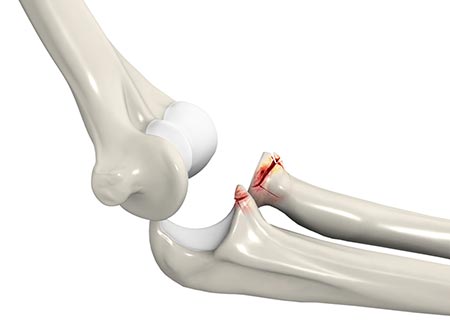One of the more complicated (and fortunately relatively rare) injuries one can sustain to the elbow is called the ‘Terrible Triad’ injury. This typically occurs when a patient falls on their outstretch arm with the elbow extended and dislocates the elbow joint. When dislocation occurs, the radial head and coronoid process (the ends of the radius and ulna that articulate with the distal humerus to form the elbow joint) fracture as well. Additionally, soft tissue damage occurs including tearing of the medial and lateral collateral ligaments that provide stability to the elbow. This is called The Terrible Triad.
This injury is treated with surgical management to restore alignment of the elbow joint, fix, remove, or replace the fractured radial head, fix the coronoid process fracture, and reconstruct the surrounding soft tissue. The associated recovery includes brief immobilization followed by therapy to regain function.
For some rather unlucky patients, elbow fracture dislocations may also come with wrist pain and stiffness. It is not uncommon for the force of the impact at the time of injury to transmit through the forearm to the distal aspect of the radius and ulna bones at the wrist joint and cause dislocation. The interosseous membrane/ligament (IOM/L) that connects these bones in the forearm is also disrupted. This injury is called an Essex-Lopresti Fracture-Dislocation. It often goes undiagnosed initially due to attention being focused on the elbow itself. Patients may report wrist pain and dysfunction while they rehabilitate the elbow post-operatively. X-rays may show that the radius bone has shifted toward the elbow joint, which puts more stress on the ulna where it forms the wrist joint.
The symptoms associated with an Essex-Lopresti injury typically persist unless addressed surgically. Acute management typically includes repair of the distal radial ulnar joint (DRUJ) and internal stabilization of the interosseous membrane. Alternatively, if surgical intervention is not performed acutely, surgery may consist of an IOM/L reconstruction possibly with an ulnar shortening osteotomy (shortening the ulna to restore appropriate alignment). The goal of surgical intervention is to restore alignment and support to both the elbow and the wrist.
If all aspects of this injury are not appropriately identified and treated accordingly, patients often struggle with chronic pain and stiffness in both the wrist and elbow. Alternatively, if thorough imaging and evaluation is completed and both the elbow and wrist are treated concurrently, patients typically do well once recovered and hopefully return to their baseline of function.




